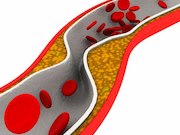No association with ICH; within HDL, cholesterol inversely and triglyceride positively linked to MI
TUESDAY, Feb. 13, 2018 (HealthDay News) — Lipoproteins and lipids are similarly associated with risk of myocardial infarction (MI) and ischemic stroke (IS) but not intracerebral hemorrhage (ICH), according to a study published in the Feb. 13 issue of the Journal of the American College of Cardiology.
Michael V. Holmes, M.D., Ph.D., from the University of Oxford in the United Kingdom, and colleagues evaluated the associations of plasma metabolic markers with risks of incident MI, IS, and ICH. Nuclear magnetic resonance spectroscopy was used to measure 225 metabolic markers in baseline plasma samples as part of a nested case-control study.
Based on samples from 912 MI, 1,146 IS, and 1,138 ICH cases, as well as 1,466 common control subjects, the researchers found that very low-, intermediate-, and low-density lipoprotein particles were positively associated with MI and IS. There was an inverse association between high-density lipoprotein (HDL) particles and MI apart from small HDL. No lipoprotein particles were associated with ICH. There was an inverse association between cholesterol in large HDL and MI and IS (odds ratio [OR], 0.79 and 0.88, respectively), while cholesterol in small HDL was not associated with MI and IS (OR, 0.99 and 1.06, respectively). Triglycerides within all lipoproteins were positively associated with MI and, similarly, IS.
“Lipoproteins and lipids showed similar associations with MI and IS, but not with ICH,” the authors write.
One author disclosed financial ties to the pharmaceutical industry.
Abstract/Full Text (subscription or payment may be required)
Editorial (subscription or payment may be required)
Copyright © 2018 HealthDay. All rights reserved.








